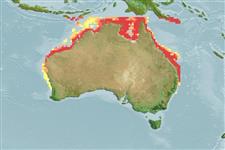Common names from other countries
Classification / Names / Names
आम नाम | उपशब्द | Catalog of Fishes (gen., sp.) | ITIS | CoL | WoRMS
Environment: milieu / climate zone / depth range / distribution range
पारिस्थितिकी
; गहराई सीमा 8 - 61 m (Ref. 105423). Subtropical; 10°S - 33°S, 112°E - 154°E
Indo-Pacific: Endemic to Australia.
Length at first maturity / आकार / वज़न / Age
Maturity: Lm 2.2 range ? - ? cm Max length : 14.5 cm TL पुल्लिंग / अलिंग; (Ref. 8); 15.5 cm TL (female)
Found on seagrass and offshore habitats (Ref. 104903). Postlarvae settle exclusively in seagrass beds (Ref. 84594). Juveniles live almost exclusively in shallow seagrass beds (Ref. 105190). They feed on bivalves, gastropods, ophiuroids, crustaceans and polychaetes (Ref. 104903), diatoms, filamentous algae, and seagrass (Ref. 105190).
Life cycle and mating behavior
परिपक्व अवधि | पुनरुत्पत्ति | मछलीऔ का अंडे देना | अंडे | Fecundity | लार्वा
Members of the order Decapoda are mostly gonochoric. Mating behavior: Precopulatory courtship ritual is common (through olfactory and tactile cues); usually indirect sperm transfer.
Holthuis, L.B. 1980. (Ref. 8)
IUCN Red List Status (Ref. 130435)
CITES status (Ref. 108899)
Not Evaluated
Not Evaluated
Human uses
मात्स्यिकी: व्यापारिक
FAO - जलीयकृषि: production; | FishSource | Sea Around Us
साधन
इंटरनेट स्रोत
Estimates based on models
Preferred temperature
(Ref.
115969): 24.6 - 28.2, mean 26.7 (based on 184 cells).
लौटाव
ऊंचा, न्यूनतम जनसंख्या दुगनी समय अवलागत 15 महीने। (K=2.16-4.21).
Vulnerability
Low vulnerability (10 of 100).
